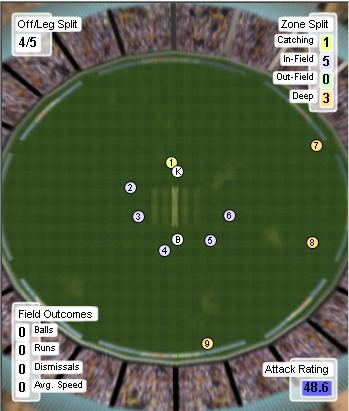How to spin out a batsman set on defence
Picture the scene; you are playing in a English declaration game. The weather is set fair and after batting first you have enjoyed an excellent tea.
The opposition start well, but lose a flurry of quick wickets. With 6 over to go 22 runs are needed but numbers 10 and 11 are at the wicket.
So they shut up shop, batting out to save the draw.
In first class cricket the plan would be simple.
Both bowlers and wickets are better quality. That means the average top level spinner gets more dip, turn and bounce than his club or school counterpart.
So he sets a wall of close fielders; slip, gulley, silly point, short leg and more. He spins the ball hard looking for the edge behind or onto bat-pad. Well armoured men bravely stay low and take the catches when they come.
But there are problems with this plan at lower levels of cricket.
Fielders don't like risking life and limb in close catching positions. They rarely, if ever, practice taking bat-pad catches and helmets are not worn as frequently as they should be (in fact, in junior cricket fielding in close might even be banned by governing body regulations).
There is less turn, dip and bounce in club games, so even with close men in, a decent tail-ender can lunge forward without fear of the ball going to hand.
Unless number 11 is a total rabbit, it's unlikely your spinner (or even your quickest bowler) can beat his or her defence.
Tail-enders like putting bat on ball. They don't get to the middle much and when they do they want to make the most of their chance. Of course, most are going to be sensible enough to pat back the slow bowler at first, but as confidence grows that the bowling is 'easy' so does the chance of a big shot.
We have all seen it in our team's late order; walking back, shaking his head muttering "why did I play that shot?"
So, as batsman playing shots are more likely to get out, it's your job as bowler or captain to encourage such behaviour.
So rather than have close fielders aplenty you would have a field something like this (for an off spinner to a right handed tail-ender):
A left arm or leg spinner would be similar with a short third man.
The field is telling the batsman the bowling is poor and he expects to be hit. So the batsman will, on realising he can win the game with a few choice blows against such weak bowling, have a go, hitting it straight up to mid on or midwicket or missing a straight one.
So, going back to our original situation, ask yourself what is more likely on a slow wicket with an old ball: getting a bat-pad against a number 11 set on defence, or seeing his eyes light up when a gentle spinner throws the ball up with a defensive field?
- Login to post comments


